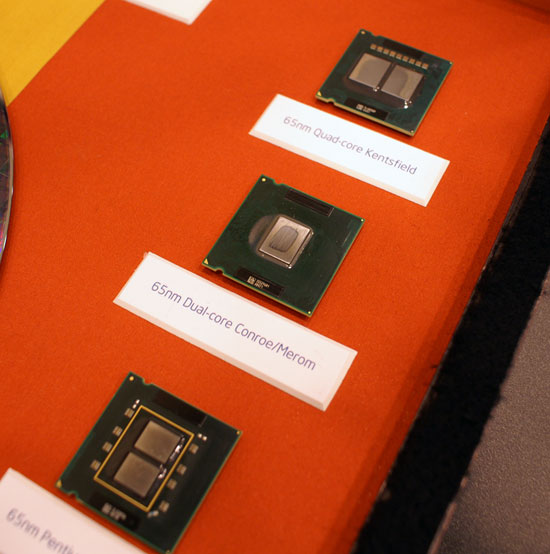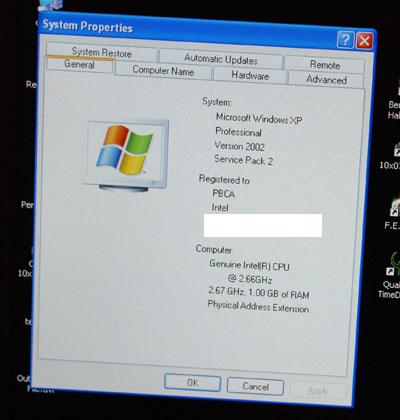Spring IDF 2006 Conroe Preview: Intel Regains the Performance Crown
by Anand Lal Shimpi on March 7, 2006 3:58 PM EST- Posted in
- Trade Shows
Intel is very excited about its new Core architecture, especially with Conroe on the desktop. It's not really news to anyone that Intel hasn't had the desktop performance crown for years now; its Pentium 4 and Pentium D processors run hotter and offer competitive or lower performance than their AMD competitors. With Conroe, Intel hopes to change all of that.

From top to bottom - Quad-core 65nm Kentsfield, dual core 65nm Conroe and 65nm Pentium D
Intel setup two identical systems: in one corner, an Athlon 64 FX-60 overclocked to 2.8GHz running on a DFI RD480 motherboard. And in the other corner, a Conroe running at 2.66GHz (1067MHz FSB) on an Intel 975X motherboard.


The AMD system used 1GB of DDR400 running at 2-2-2/1T timings, while the Intel system used 1GB of DDR2-667 running at 4-4-4. Both systems had a pair of Radeon X1900 XTs running in CrossFire and as far as we could tell, the drivers and the rest of the system setup was identical. They had a handful of benchmarks preloaded that we ran ourselves, the results of those benchmarks are on the following pages. Tomorrow we'll be able to go into great depth on the architecture of Conroe, but for now enjoy the benchmarks.
As far as we could tell, there was nothing fishy going on with the benchmarks or the install. Both systems were clean and used the latest versions of all of the drivers (the ATI graphics driver was modified to recognize the Conroe CPU but that driver was loaded on both AMD and Intel systems).
Intel told us to expect an average performance advantage of around 20% across all benchmarks, some will obviously be higher and some will be lower. Honestly it doesn't make sense for Intel to rig anything here since we'll be able to test it ourselves in a handful of months. We won't say it's impossible as anything can happen, but we couldn't find anything suspicious about the setups.










220 Comments
View All Comments
raskren - Wednesday, March 8, 2006 - link
Get a grip.Nighteye2 - Wednesday, March 8, 2006 - link
You'd have more chance sueing Intel for that. Anandtech could easily have been honestly misled, with no ill intent. Sue the one who sents the message, not the messenger.peternelson - Wednesday, March 8, 2006 - link
Well this article has precipitated quite a lot of AMD vs Intel debate.
However my comment is about the MOTHERBOARDS for Conroe.
You say the test was done on "AN Intel 975X motherboard".
You might have been more specific as to the motherboard model. ie was it one of those "BAD AXE" 975X motherboards you recently reviewed (with a bios update) or some other yet to be released Intel board - (the so-called "platform refresh")?
Since Conroe exists now and specs are being talked about at IDF, can you establish PRECISELY what voltage specification it requires from the motherboard? There has been much confusion about this on the web and no definitive statement.
It seems to me the up to date VRM (module) or VRD (on mobo regulation) spec is VRD 10.1
Can you establish from Intel that a board complying with VRD 10.1 is sufficient for Conroe requirements or establish very precisely what it may need IN ADDITION to VRD10.1.
Now, having said that, you have reviewed FOUR 975X boards. Can we say if any or all of these may be legitimately described as "Conroe ready"? Maybe ask if they are designed to VRD 10.1?
Also I thought you were going to review more 975X based boards - eg what about MSI, ECS, DFI?
If purchasing an expensive motherboard I would like it to be at least a slightly medium term investment, so being able to take the next cpus is an important influencing factor. Since the 975X chipset will support conroe, it would be a shame if the motherboard didn't. Therefore please can you tell us (from Intel at IDF or the mobo makers at CEBIT) which CURRENT boards will work with Conroe?
Finally as a general point on the 975X reviews... There were repeated comments that they did not include Firewire 800 as being a big error! I disagree!
I would certainly value the second Gigabit ethernet port, but firewire B? Unnecessary. The chipsets are more expensive and look at the adoption - some macs and little else uses it. Firewire 400 is ubiquitous because of iLink DV Camcorders. But the 800 speed is now obsolete! Why? Because of SATA and ESATA. ESATA 300 blows away firewire 800 in performance. Someone who needs high disk bandwidth will use SATA/SATA2/ESATA, SCSI or SAS. USB disks suffer from excessive overhead and simplex comms, firewire suffers arbitration penalties when you go above one drive. SATA is by far the preferred technology to any serious users, and ESATA offers a way to make it external and portable. Don't criticise motherboard manufacturers for leaving out the Firewire 800. It seems they all think alike on this matter, so they must think like me.
2803 - Wednesday, March 8, 2006 - link
So if I go get last years top AMD board...set it up to be slow as possible and then take an Intel processor that won't be out for 6 months and compare the two...can I get paid to post the results on here too.I hope some sues your pants off for false statements resulting in share holder losses.
Clauzii - Wednesday, March 8, 2006 - link
On my old AsRock AK7S41, if I drive the FSB higher than around 148, the machine boots saying it´s a XP2700 Unknown.For the driver issue: I won´t complain if rewriting the ATI (or nVidia) drivers for stuff - I´d raise my hands and say thank´s, that´s what I paid for (performance, stability, support etc.).
I´m in no doubt confident that AMD will comming up with their stuff in due time, and keeping talking about CPUs as some kind of war going on is utterly nonsens to me. It´s not a war but progress/evolution/engineering/refinement that goes on and on and on and on...
And just like tidal waters things keep changing. But roughly 200 posts on a thing that´s not gonna be out in 6 months - I´m wasting my time here....
(AMD user since 2002)
EnergyWatcher - Wednesday, March 8, 2006 - link
From http://voodoopc.blogspot.com/">http://voodoopc.blogspot.com/...
First of all, though it’s claimed that you’re running an FX-60 processor on the machine, I have yet to see an established motherboard and processor with an image that says "processor unknown".
You’ll notice that the image I am referring to on Anandtech's website states that the AMD processor is “unknown” which makes me believe that the bios they are running is outdated. So, I did a bit of digging and low and behold, the DFI bios version “D49C-32” they are running is from 10/11/05. There has been 1 major revision with major fixes that include:
Set Cool 'n' Quiet Default to Disabled
- With Cool & Quiet enabled, AMD processors will throttle in order to save power and bring their thermal load down. This means the processor could be running as low as 800MHz in certain programs – no matter what the program is. In theory Cool & Quiet is supposed to throttle up to maximum in games but this is not always the case. No enthusiast PC goes out with Cool & Quiet enabled unless it’s a fanless machine or media center.
Add Support for AMD Athlon 64 FX60 CPU
- According to DFI the FX-60 will not operate correctly without this bios update. Without official support for the FX-60 CPU I’m not sure what we’re comparing against here.
Fix Memory Timings 2-1-1-1-1 and 4-1-1 Mode Wrong & Fix Read Preamble Table Error.
- Memory latency can make a massive difference in performance. If the latency was not running at the correct latency we can see a pretty big difference in all kinds of performance. Anandtech stated “The AMD system used 1GB of DDR400 running at 2-2-2/1T timings…” Apparently this isn’t the case, but they would not be able to tell without having the platform in house.
Fix Fill 3114 SVID&SSID under Cross fire mode.
- More apparent performance issues under Crossfire mode.
Next, when you take a future Intel chipset and compare it to a chipset that no enthusiast supports (RD480) with an outdated bios it’s like taking a Ferrari and putting it on Bias-Ply tires. It’s just not a good way to show off a “new” technology.
...
So now a few numbers caught my attention based on another email I received last night.
If we go and check out the numbers on Anandtech we’ll see the Unreal Tournament 2004 benchmark showing 160fps on the unknown AMD X2 processor while the Intel Conroe at 2.66GHz came in significantly higher at 191fps.
Though this isn’t exactly conclusive, if you go back and re-read some old FX-57 reviews on Tom’s Hardware you’ll see a benchmark for the same game set at the same resolution, the FX-57 running at 2.8GHz scored 183.4fps. The funny thing is it’s using an Nvidia Geforce 6800 GT which seems to me that something is totally wrong here - perhaps it's somewhere locked in the settings, but I won't know until I sit down and compare our own benchmarks with consistant settings. Note that a single core Athlon 64 4000 achieved a better score in the benchmark run by Tom (160.5fps) than the one provided by Intel (160.4) at IDF. Here is a link to Tom’s review. http://www.tomshardware.com/2005/06/27/athlon_64_f...">http://www.tomshardware.com/2005/06/27/athlon_64_f...
...
finalfan - Wednesday, March 8, 2006 - link
BY the way, you can take a look at http://www.anandtech.com/video/showdoc.aspx?i=2540...">http://www.anandtech.com/video/showdoc.aspx?i=2540... which shows FX55 running on a ATI X800XT. For the same game, at same resolution, it only scored 67.3 while 6800 scored 66.8. Of course, 6800GT perform better than 6800, but it won't make me to believe that a FX57 and 6800GT can score 183 if the same demo is used.Based on the fact, the demo toms used is no way the same as Intel used.
finalfan - Wednesday, March 8, 2006 - link
Good catch. But a small line under Unreal Tournament says it's using THG demo. S they are not the same demo.Nighteye2 - Wednesday, March 8, 2006 - link
Intel preparing the overclocked AMD system, as well as the benchmark programs...They may have done a nice job on making it look like nothing's been tampered with, but for the moment I remain skeptical.
Let's all just wait and see Conroe's true performance, after it hits the market.
flyck - Wednesday, March 8, 2006 - link
http://voodoopc.blogspot.com/">the cripplingdoes not change the fact that conroe is an impressive cpu. can't wait to see what it does against AM2 in 6 months